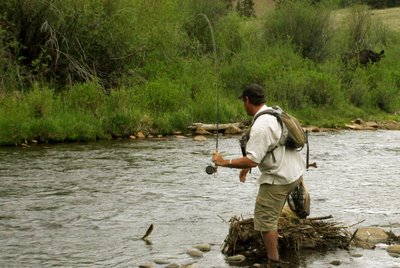Fly Fishing Playoffs (Terrestrial Division)

In the cycle of seasons, it is approaching that time of year when the evening twilight sneaks in noticeably earlier. Some anglers get a natural feeling that the season is ending and it is time to hang up their 'uniforms', but for many fly fisherman this time of year signifies the end of the regular season and the start of the 'playoffs'. This change can generally be marked with exceptional terrestrial fishing on many of the rivers throughout the Rockies.
Making this transition can involve some giggling at the sight of these of big, colorful and often wiggly looking patterns made of foam, rubber, hair and unimaginable list of ingredients. It seems as if a switch is flipped and the same fish that seemed to thoroughly investigate the delicate mayfly pattern for any sign of unnatural ‘behavior’ is now erupting on fly patterns that resemble small balloon animals.
Just about every river in our network is reporting great action on these silly looking patterns during portions of the day. Particular patterns and times of day are varying from place to place but here are some tips to that will increase your success at your local ‘stadium’:
1) Use the appropriate tippet size. Many of these patterns are big and wind resistant which will need to have a stiffer line to help the fly turnover and prevent ‘twisting’.
2) Use shorter leaders. By using leaders no longer than 8ft. will increase accuracy and allow for a rapid turnover of the pattern to create the “splashy” presentation of falling terrestrials.
3) Present under and around structure. Even if you don’t see risers, some of the larger fish will be hunkered in and around good structure and will leave these safe havens for a floating ‘bratwurst’.
4) Make sure your pattern is lying flat on the surface. Many of these patterns use rubber legs which make an “X” when sitting on the water properly. If your fly is drifting on one side give it a little ‘tug’ to straighten out the ‘lie’.
5) Use terrestrials as an indicator. Tie on different lengths of tippet to the end of a terrestrial pattern and drop a nymph or emerger pattern below. This will allow you to fish more of the water column.
6) Pinch down your barb. By removing the barb on larger hooks you will increase the ability to penetrate the mouth and minimize damage to the fish.
Of course, these tips will only be helpful if you get out to the river and be committed to throwing these types of patterns. Fortunately, unlike the playoffs in other sports, the ‘win or go home’ is optional.
For specifics on the terrestrial fishing conditions around the Rocky Mountain Region visit our website: http://www.flycurrents.com




